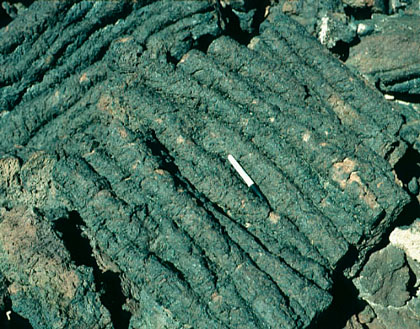
Cosmogenic dating of young basaltic lava flows
On This Page
Cosmogenic dating techniques have been successfully applied to dating of geomorphically-young surfaces, such as glacial moraines, beach terraces, and basaltic lava flows that have intact surface features, and hence have undergone little erosion (e.g. Phillips et al., 1997a and b; Phillips et al, in review, Dunbar and Phillips, 1996; Zreda et al., 1991, 1993; Zreda, 1994; Anthony and Poths, 1992, Laughlin et al., 1994). These techniques rely on measurement of cosmogenic nuclides that begin to build up as soon as a rock is exposed to cosmic rays. Therefore, cosmogenic techniques can be applied to dating of any surface that is composed of material that was not exposed to cosmic rays prior to formation of the surface, and has been exposed more-or-less continuously since. In the case of an extrusive volcanic rock, buildup of cosmogenic nuclides begins when the rock is erupted, so measurement of the ratio of a cosmogenic isotope to a non-cosmogenic isotope can provide an estimate of eruption age (Phillips et al., 1986).

The chlorine-36 method (Phillips et al., 1986) is based on the fact that 36-Cl is dominantly produced by cosmogenic reactions near the earth's surface, primarily in the upper 1 m. of an exposed rock, as compared to a very small amount of production in the deeper subsurface. Chlorine-36 is produced in rocks at the earth's surface almost entirely by cosmic-ray-induced reactions. These include spallation of 39-K and 40-Ca, and thermal neutron activation of 35-Cl. Cosmic rays are attenuated by interaction with the earth's magnetosphere and atmosphere, so the production of 36-Cl is dependent on the latitude and elevation at which the sample was collected. Cosmic rays are also attenuated by any material overlying the dating surface, such as windblown sand or snow, so in order for a meaningful age to be obtained, the surface either must have remained bare since initial exposure, or the cover history must be accurately known.
References
- DUNBAR, N., 1999, Cosmogenic 36-Cl-determined age of the Carrizozo lava flows, south-central New Mexico: New Mexico Geology, v. 21, p. 25-29. ABSTRACT
- DUNBAR, N. W., and F. M. PHILLIPS, 1994, 36-Cl surface exposure determinations of eruption ages for quaternary lava flows of the Zuni-Bandera volcanic field: New Mexico Geology, v. 16, p. 80.
- DUNBAR, N. W., and F. M. PHILLIPS, 2004, Cosmogenic Chlorine-36 ages of lava flows in the Zuni-Bandera volcanic field, north-central New Mexico, U.S.A., in: Tectonics, geochronology, and volcanism in the Southern Rocky Mountains and Rio Grande rift, Cather, Steven M.; McIntosh, William C.; Kelley, Shari A., ed(s), New Mexico Bureau Geology Mineral Resources, Bulletin, v. 160, pp. 309-317 CD-ROM. ISBN: 1-883905-21-4
- PHILLIPS, F. M., N. W. DUNBAR, and M. G. ZREDA, 1997, A Test of Chlorine-36 for Dating of Late Quaternary Basaltic Volcanoes [abs]: Eos, Transactions, American Geophysical Union, v. 78, p. 760.


